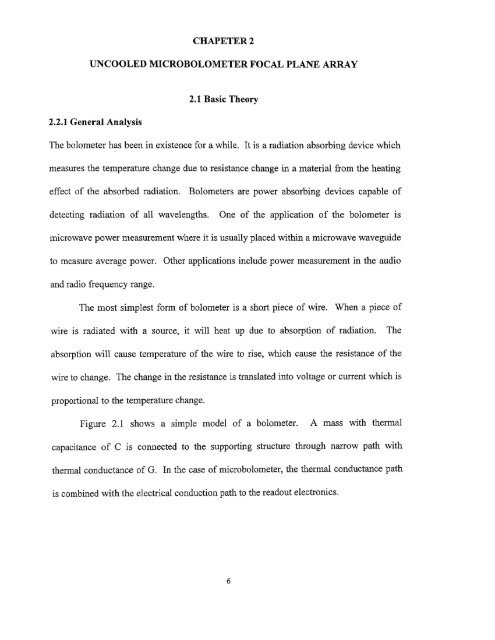Analysis of 320X240 uncooled microbolometer focal plane array ...
Analysis of 320X240 uncooled microbolometer focal plane array ...
Analysis of 320X240 uncooled microbolometer focal plane array ...
Create successful ePaper yourself
Turn your PDF publications into a flip-book with our unique Google optimized e-Paper software.
CHAPETER 2UNCOOLED MICROBOLOMETER FOCAL PLANE ARRAY2.1 Basic Theory2.2.1 General <strong>Analysis</strong>The bolometer has been in existence for a while. It is a radiation absorbing device whichmeasures the temperature change due to resistance change in a material from the heatingeffect <strong>of</strong> the absorbed radiation. Bolometers are power absorbing devices capable <strong>of</strong>detecting radiation <strong>of</strong> all wavelengths. One <strong>of</strong> the application <strong>of</strong> the bolometer ismicrowave power measurement where it is usually placed within a microwave waveguideto measure average power. Other applications include power measurement in the audioand radio frequency range.The most simplest form <strong>of</strong> bolometer is a short piece <strong>of</strong> wire. When a piece <strong>of</strong>wire is radiated with a source, it will heat up due to absorption <strong>of</strong> radiation. Theabsorption will cause temperature <strong>of</strong> the wire to rise, which cause the resistance <strong>of</strong> thewire to change. The change in the resistance is translated into voltage or current which isproportional to the temperature change.Figure 2.1 shows a simple model <strong>of</strong> a bolometer. A mass with thermalcapacitance <strong>of</strong> C is connected to the supporting structure through narrow path withthermal conductance <strong>of</strong> G. In the case <strong>of</strong> <strong>microbolometer</strong>, the thermal conductance pathis combined with the electrical conduction path to the readout electronics.6
















